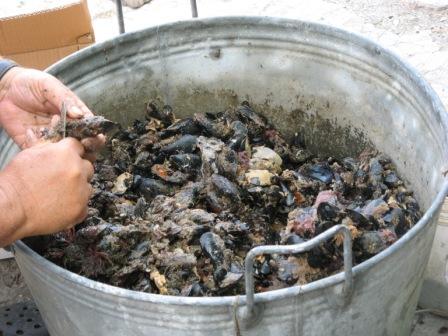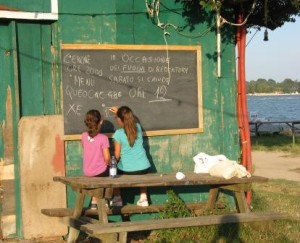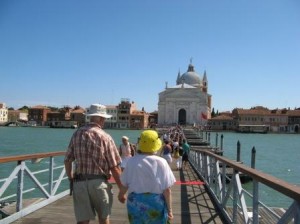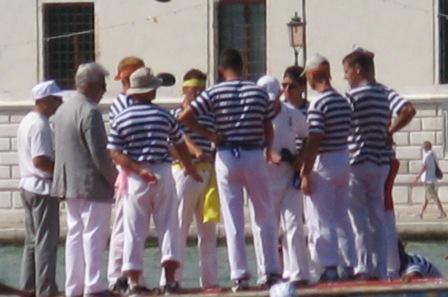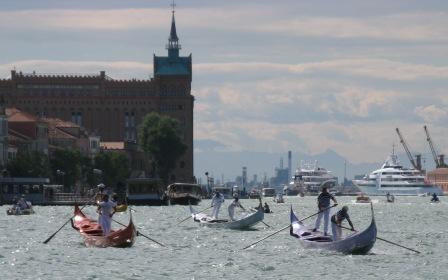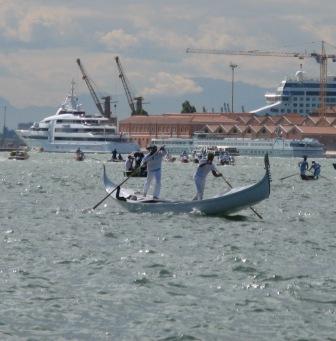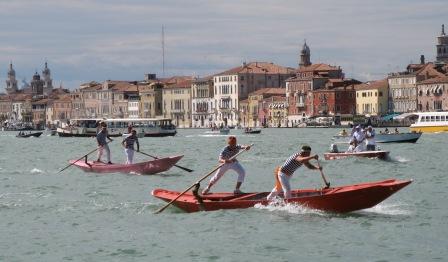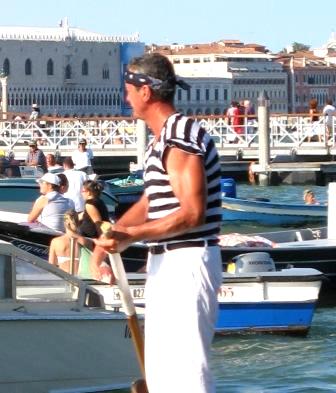The catastrophe of the Costa Concordia two weeks ago today has been a good thing in at least one (sorry, I mean only one) way: It has given a turbo-boost to the local opposition to allowing big cruise ships to slide past the Piazza San Marco like floating Alps.
By now, images of these behemoths and Venice have become as trite as Venice and acqua alta.
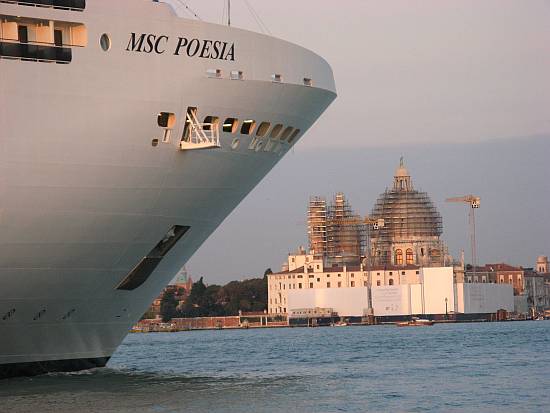
There was murmuring before, but the death of a ship and some of its people has created a good deal of commotion, not only in Venice but also at the national level, concerning the desirability of allowing these ships to come here. Needless to say, the political parties have all hoisted their shields and battle-axes and are ready for combat. And, as usual, the trumpet sounding the charge tends to drown out any other sound.
I’d like to review the main points, though I have to warn you that this subject, like most other subjects here, has become a mass of insanely knotted statistics and semi-statistics and facts and semi-facts interpreted in 11,552 different ways, according to who is speaking and, ergo. what they want. Debates of the pros and cons of heavy cruise ship traffic in the world’s most beautiful city and environs are so loaded with emotion that it has become virtually impossible to hear what anybody’s really saying, though the various viewpoints are fairly simple to summarize.

Pro: There is only one item in the “pro” column on the proverbial yellow legal pad, and that’s “Money.” Venice has done everything possible to attract and keep cruise business. In 2000, only 200 ships visited Venice, and it is now the Number One cruising homeport in the Mediterranean, and the third in Europe. With the shrinking of the income from the Casino, the starving city budget is being kept alive primarily by this new touristic medium.
Don’t be distracted by the number of companies whose ships come to Venice (43), or how many ships visited last year (654) or the number of transits they made of the Bacino of San Marco (1,308) — I’d have thought there were more — or the number of passengers last year (2,248,453), even though all these numbers are pretty impressive (fancy way of saying “huge and scary”).
The only number that matters to the city, and the only factor which virtually guarantees that cruising will continue to be crucial here, is the money the city earns from it: 300 million euros (US$390,246,000) last year.
If you want to object to cruising in or around Venice, you need to come up with a suggestion for some other activity that will make that kind of money. Or, preferably, even more. Feel free to get back to me on this.
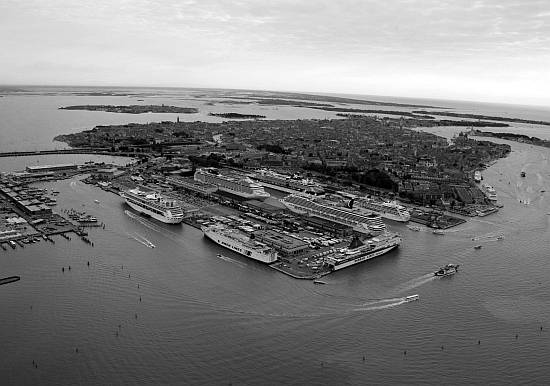
The two main items in the “con” column concern the environmental damage wrought by the floating Alps.
They are:
Erosion caused by waves (there are no waves) and/or by the suction of the motors. This suction is real: I can attest that the motors of these ships perform a phenomenal sucking/pushing action, very much like what happens to the mouthwash when you rinse your mouth. I have seen with these very eyes the waters surging in and then surging out as a ship passes, even if it passes at a distance. It’s hard to think that this could be unimportant. As we know from the humbler but more destructive daily motondoso, water going into a fissure in a foundation pulls something with it — soil, mainly — when it comes out. This eventually creates empty spaces under buildings and sidewalks.

A study done by Worcester Polytechnic Institute on the hydrodynamic effect of big ships found this: “As cruise ships pass smaller canals along the St. Mark’s Basin and Giudecca Canal, they displace and accelerate the surrounding body of water, essentially pulling water from the smaller canals. This caused a noticeable increase in canal speed and a drop in the water levels. A total of five velocity tests were completed resulting in a 57.4% increase in canal speed, and two canal height tests were completed which showed an average water level drop of 11 c (4.3 inches). The observations suggest that the root cause for these accelerations can be explained by the Bernoulli Effect: the colossal geometry of cruise ships creates fast currents and low pressure areas around the moving vessels.”
Particulate Matter, the form of air pollution made up of tiny bits of stuff from combustion exhaust. Nobody made an issue of this when Venice was a real industrial center, and nobody brought it up when the Industrial Zone on the shoreline was going full blast. Nobody made an issue of it, Lino points out, when everybody — everybody — heated their homes or cooked using wood or coal. “You didn’t need to smoke anything,” he said — “smoke was everywhere.” But particulate matter from the ships is intolerable.

Four days after the Concordia ran aground, Corrado Clini, the new Minister for the Environment, came to Venice for a day. He was shown a number of things (MoSE was not on the list, which I can understand, because nothing can be done about it now), but the subject on everybody’s mind was the big ships.
He offered the following opinion: “Common sense suggests that if the principle value to care for is our natural patrimony, the fundamental resource for our tourism, we must avoid that it be put at risk.” You can’t argue with that.
He continued: “The traffic of these ‘floating apartment buildings’ in the Bacino of San Marco, with a notable impact, are without utility for the environment and for tourism.” If he is seeking utility for tourism, all he has to do is look at the municipal balance sheet. However, “without utility for the environment” is hard to refute.
Luca Zaia, the President of the Veneto Region, who was on hand, remarked that “The big ships in Venice are dangerous and certainly a problem to resolve. I have to admit that to see these colossi at San Marco is, to say the least, horrifying.” I myself have to admit that it’s odd that he only became horrified after the Concordia ran aground; the ships have been passing for years.
Giorgio Orsoni, the mayor of Venice, contributed these observations: “The subject of the big ships is an open one. With the Port Authority we have begun to reflect on a rapid solution which will satisfy the touristic system as well as the economic one.” Rapid solutions are not easy to come up with, because every player wants his concerns to come first. Nor would a rapid solution instill much confidence. If complex, well-reasoned solutions haven’t been found yet, why would a rapid one be any easier to devise, much less implement?
Sandro Trevisanato, president of VTP, which runs the port, stated that the big ships are the least polluting form of tourism, adding that the buses, the big launches, and cars create much more pollution than the big ships. (For the record, I’d like to say that this is the most intelligent comment so far.) He points out that emissions are one of the arguments used by those who want to ban the cruise ships from the lagoon, far beyond the aesthetic question. It’s a question of taste,” says Trevisanato. “In a few seconds the ships have passed and disappear.” Seconds? Has he never stood on the embankment on a summer Sunday evening to watch the March of the Pachyderms as they depart? Even one ship, by my estimate, takes at least 45 minutes to pass from Tronchetto to Sant’ Elena. And there could easily be seven of them, virtually nose to tail.
In any case, everybody directly involved in cruise tourism agrees that pollution must be kept at “level zero.” How to do that isn’t explained.
As for the possibility — remote, all agree — that something could go wrong with the motors, or that the ship for some other reason would suddenly become ungovernable, and that the force of inertia would impel it to ram bow-first into the Piazza San Marco or some other bit of Venice, Trevisanato says that the port is one of the most secure in the world, as the ships are protected from the effect of wind and waves, and the ships pass at a reasonable (I put that in) distance from the shores. Hard to say what is “reasonable” when the Giudecca Canal is only 320 meters (1000 feet) wide, or less. But you will have noticed that referring to wind and waves prevented him from discussing the consequences of a big ship going adrift in the Bacino of San Marco.
Someone reminded him that in 2004 the ship “Mona Lisa” ran aground in the fog in the Bacino of San Marco. His reply: “Exactly: and nothing happened.” This is true; the ship was on its way after a mere hour, undoubtedly thanks to the help of the rising tide. But the “Mona Lisa” is 201 meters (609 feet) long by 26 meters (85 feet) beam, and a gross tonnage of 28,891; not exactly a floating Alp.
The Concordia was 292 meters (958 feet) x 35.5 meters (116 feet); gross tonnage 112,000.
In any case, saying “Nothing happened” isn’t very helpful. It brings to mind the famous exchange in a Ring Lardner story: “‘Daddy, are we lost?’ ‘Shut up,’ he explained.”
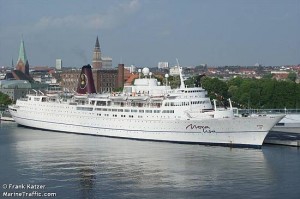
And the mayor’s statement that a “rapid solution” is in the works isn’t very reassuring, even if it were true. Solutions have been debated for years.
Proposed solutions so far:
Building an “offshore port” in the Adriatic where the floating Alps would tie up, and offload passengers (and luggage) into launches which would bring them to Venice. Objections: Cost, feasibility, and the obvious pollution, primarily motondoso, which would be caused by thousands of launches trundling to and fro all day. I can add the element of potential danger to people, if not to Venice, of boarding and traveling in a launch when the bora is blowing.
Make the Bacino and the Giudecca Canal a one-way street. Tourists get to snap the Piazza San Marco either coming or going, but not both. This has the advantage of not depriving them totally of this scenic opportunity, while cutting in half the number of transits. A tour operator told me that it isn’t uncommon for a potential cruise customer to ask if the ship passes in front of the Piazza San Marco. If the answer is no, it’s an immediate deal-breaker.
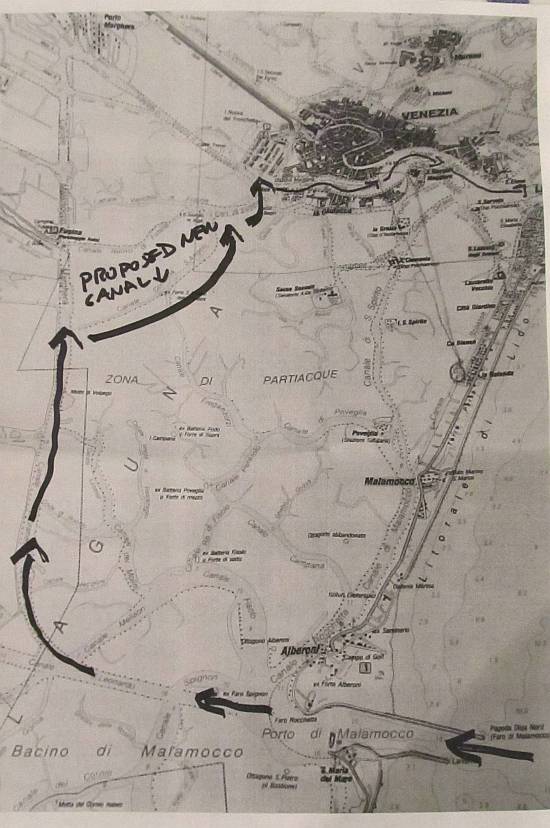
But this new system would require deepening a heretofore unimportant natural channel known as the Canal of Sant’ Angelo in order to create a sort of bypass. Enter the lagoon at the inlet at Malamocco, steam up the shoreline via the Petroleum Canal, then turn right in the Canal of Sant’ Angelo, which neatly brings the behemoth to Tronchetto. The ship would depart via the Giudecca Canal, so the passengers could all snap their photos.
Or, the ship would enter, as it does now, by the inlet at San Nicolo’, steam past San Marco (snap snap snap) to Tronchetto, then depart down the Canal of Sant’ Angelo, Petroleum Canal, and out into the Adriatic at Malamocco.
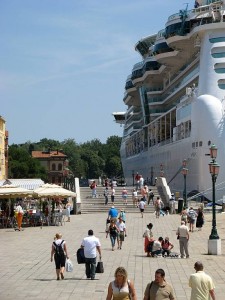
What’s extremely wrong with this idea — in my opinion, as well as many environmentalists — is that deepening the Canal of Sant’ Angelo would be a reprise of the digging of the Petroleum Canal, a deed which many have long since recognized as a disaster for the lagoon. A channel as straight as an airport runway and deep enough for cargo ships and tankers behaves like the average water faucet, concentrating and accelerating the force of the water passing through it. Many environmental groups date the beginning of the deterioration of the lagoon ecosystem from the creation of the Petroleum Canal. Among other things, it is estimated that this canal is responsible for the loss of one million cubic meters of sediment every year. We don’t have to care, but the myriad creatures and plants which depend on the sediment certainly do.
Digging another deep channel will almost certainly cause the same phenomenon, thereby multiplying the damage. Just what we need, when you add in the same effect caused by the deepening of the three lagoon inlets for the installation of the MoSE floodgates.
So the bypass canal, which looks so good on paper, would be yet another blow to an ecosystem which UNESCO, along with the city of Venice, designated as a World Heritage Site. Now that I think of it, the only group that hasn’t weighed in yet on this is UNESCO. Maybe they’re thinking.
Last idea: Forget Tronchetto. Move the whole passenger port over to the shoreline at Marghera. Docks already exist, or could be created, so logistically the idea has a lot in its favor. Except that Marghera is part of the dying Industrial Zone, with all the aesthetic appeal of a dying Industrial Zone. It’s like selling a cruise from Venice that actually starts in the Port of Newark or Liverpool. Intending no offense.
Speaking of the force of inertia, debates, meetings, commissions, studies (oh good, we can always use more of those) and assorted pronouncements will undoubtedly continue. I can make that claim because when the “Mona Lisa” ran aground in 2004, the then-mayor, Paolo Costa, ringingly declared that a stop must be put to the big ships passing in the Bacino of San Marco.
He said (translation by me): “What happened has unfortunately confirmed my worries, and that is that an absolute certainty doesn’t exist on the possibility to guarantee the security in this zone of the city (Bacino San Marco) which is so important and delicate. It was horrifying to see the ship aground a mere 30 meters from a vaporetto stop, and fortunately consequences were avoided that could have been disastrous and unimaginable. Now we must take rapid measures, more than one, and very detailed, that eliminate the danger of finding, one day, a ship in the Piazza San Marco. Because everything which today is at risk in the Bacino of San Marco isn’t something that can be protected only probably, but certainly, and with safety.”
Eight years have passed, two mayors have succeeded him, Costa is now President of the Port of Venice, and those “rapid measures” are still being fervently invoked.
The Port of Venice may be protected from potentially dangerous winds, but there seems to be no way to protect it from hurricanes of hot air.

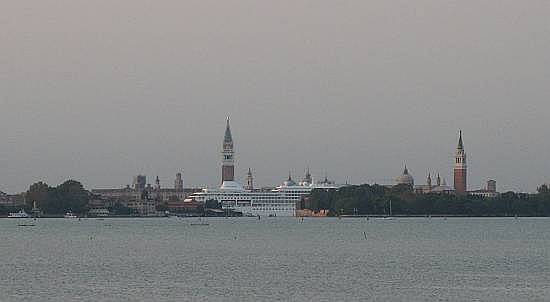
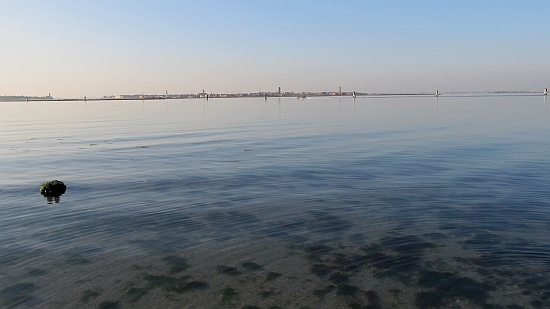
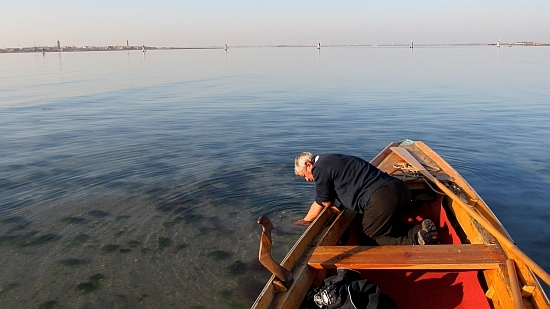
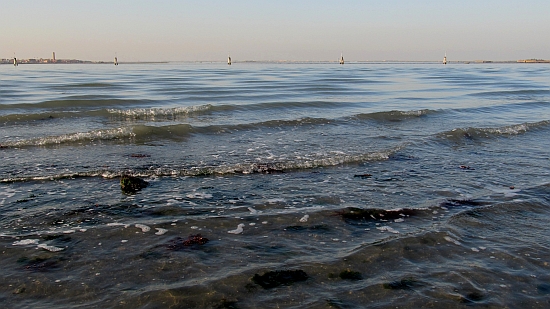
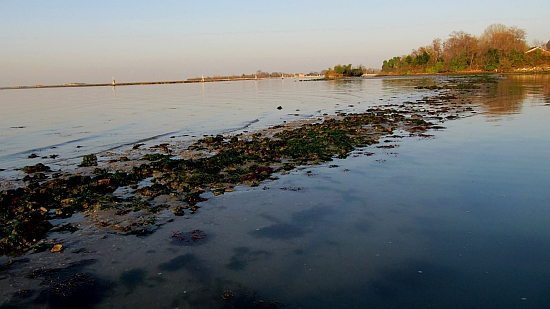

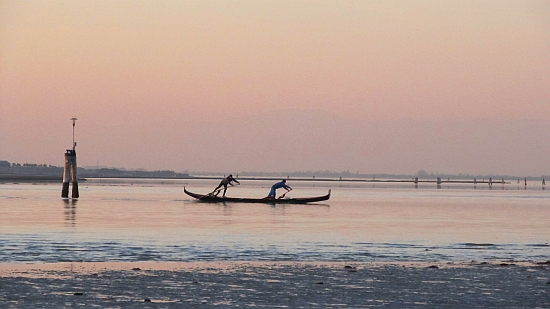
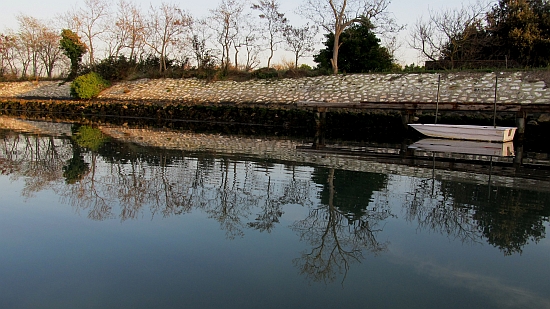
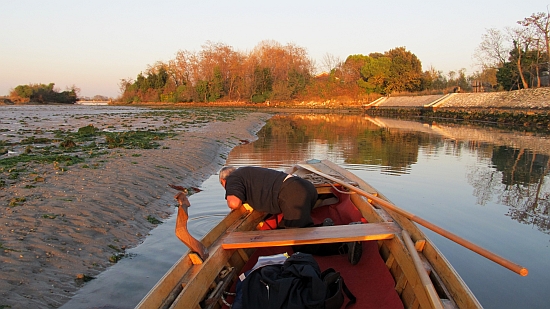
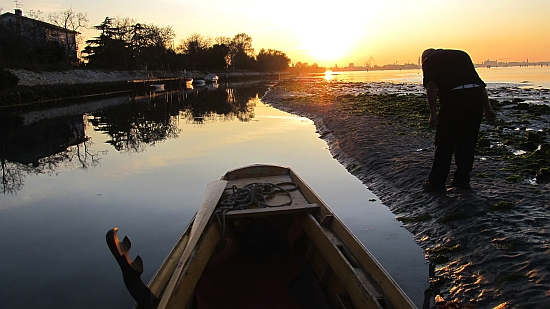
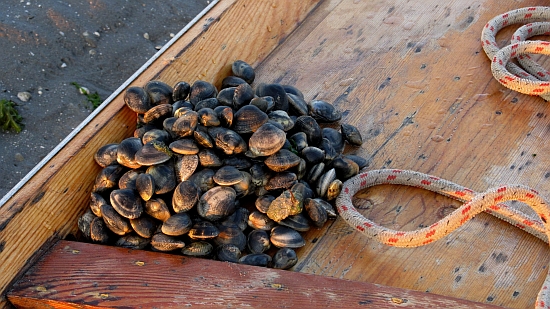

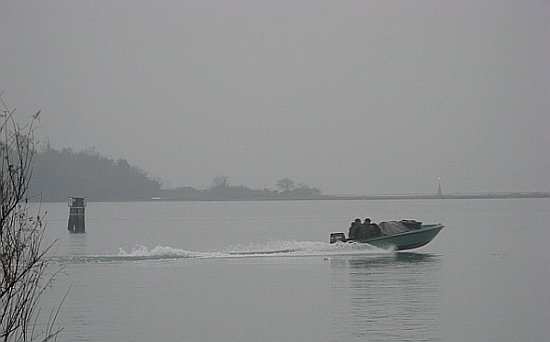
![IMG_3549 What we discovered amid the debris ashore was this treasure, a "cheba da go" [KEH-ba da GO] which had gone adrift. "Go" is the Venetian name of a type of lagoon fish technically named a goby, and this piece of equipment is still, well, ready to go. Finders keepers.](https://iamnotmakingthisup.net/wp-content/uploads/2010/12/IMG_35491-300x225.jpg) These are what I think of as the mother-of-pearl days, when the sky and water share a nacreous, faintly gleaming quality and the air is almost still. Days like this are the Japanese tea ceremony, Bach’s unaccompanied cello suites, of weather. Normal people looking out the window feel an urge to make hot cocoa and lie on the sofa. I can’t wait to get out.
These are what I think of as the mother-of-pearl days, when the sky and water share a nacreous, faintly gleaming quality and the air is almost still. Days like this are the Japanese tea ceremony, Bach’s unaccompanied cello suites, of weather. Normal people looking out the window feel an urge to make hot cocoa and lie on the sofa. I can’t wait to get out.
